Emperor of India
| Emperor of India | |
|---|---|
| Kaisar-i-Hind | |
Imperial | |
 The Star of India | |
 | |
| Details | |
| First monarch | Victoria |
| Last monarch | George VI (continued as monarch of India and Pakistan) |
| Formation | 1 May 1876 |
| Abolition | 22 June 1948 |
Emperor or Empress of India was a title used by
The title was abolished on 22 June 1948, with the
History

After the nominal
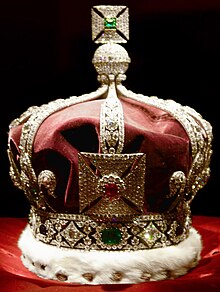
The idea of having Queen Victoria proclaimed empress of India was not particularly new, as
Many in the United Kingdom, however, regarded the assumption of the title as an obvious development from the Government of India Act 1858, which resulted in the founding of British India, ruled directly by the Crown. The public were of the opinion that the title of "queen" was no longer adequate for the ceremonial ruler of what was often referred to informally as the "Indian Empire". The new styling underlined the fact that the native states were no longer a mere agglomeration but a collective entity.[11]

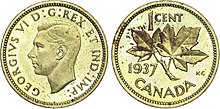
When Edward VII ascended to the throne on 22 January 1901, he continued the imperial tradition laid down by his mother, Queen Victoria, by adopting the title Emperor of India. Three subsequent British monarchs followed in his footsteps, and the title continued to be used after India and Pakistan had become independent on 15 August 1947. It was not until 22 June 1948 that the style was officially abolished during the reign of George VI.[2]
The first emperor to visit India was George V. For his imperial coronation ceremony at the Delhi Durbar, the Imperial Crown of India was created. The Crown weighs 920 g (2.03 lb) and is set with 6,170 diamonds, 9 emeralds, 4 rubies, and 4 sapphires. At the front is a very fine emerald weighing 32 carats (6.4 g).[12] The king wrote in his diary that it was heavy and uncomfortable to wear: "Rather tired after wearing my crown for 3+1⁄2 hours; it hurt my head, as it is pretty heavy."[13]
The title "Emperor of India" did not disappear when British India became the
List of emperors and empresses
| Portrait | Name | Birth | Reign | Death | Consort | Imperial Durbar
|
Royal House
|
|---|---|---|---|---|---|---|---|

|
Victoria | 24 May 1819 | 1 May 1876 – 22 January 1901 | 22 January 1901 | None[a] | 1 January 1877 (represented by Lord Lytton) |
Hanover |
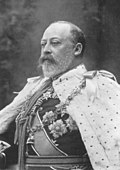
|
Edward VII | 9 November 1841 | 22 January 1901 – 6 May 1910 | 6 May 1910 | 
|
1 January 1903 (represented by Lord Curzon) |
Saxe-Coburg and Gotha |
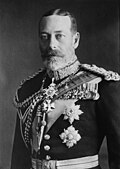
|
George V | 3 June 1865 | 6 May 1910 – 20 January 1936 | 20 January 1936 | 
|
12 December 1911 | Saxe-Coburg and Gotha (1910–1917) Windsor (1917–1936) |

|
Edward VIII | 23 June 1894 | 20 January 1936 – 11 December 1936 | 28 May 1972 | None | None[b] | Windsor |
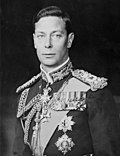
|
George VI | 14 December 1895 | 11 December 1936 – 15 August 1947 | 6 February 1952 | 
Elizabeth Bowes-Lyon
|
None[c] | Windsor |
See also
Notes
- ^ Victoria's husband Prince Albert died on 14 December 1861.
- ^ Edward VIII abdicated after less than one year of reign.
- ^ A durbar was deemed expensive and impractical due to poverty and demands for independence.[17]
References
- ^ "No. 38330". The London Gazette. 22 June 1948. p. 3647. Royal Proclamation of 22 June 1948, made in accordance with the Indian Independence Act 1947, 10 & 11 GEO. 6. CH. 30. ('Section 7: ...(2)The assent of the Parliament of the United Kingdom is hereby given to the omission from the Royal Style and Titles of the words " Indiae Imperator " and the words " Emperor of India " and to the issue by His Majesty for that purpose of His Royal Proclamation under the Great Seal of the Realm.'). According to this Royal Proclamation, the King retained the style and titles 'George VI by the Grace of God, of Great Britain, Ireland and the British Dominions beyond the Seas King, Defender of the Faith'
- ^ a b Indian Independence Act 1947 (10 & 11 Geo. 6. c. 30)
- ISBN 978-0-313-27326-1.
- ISBN 9781576079256.
- ^ L. A. Knight, "The Royal Titles Act and India", The Historical Journal, Cambridge University Press, Vol. 11, No. 3 (1968), pp. 488–489.
- ^ a b L. A. Knight, p. 489.
- ^ "Remembering Vicky, the Queen Britain never had". www.newstatesman.com. 10 June 2021.
- ^ L. A. Knight, p. 488.
- ^ B.S. Cohn, "Representing Authority in Victorian India", in E. Hobsbawm and T. Ranger (eds.), The Invention of Tradition (1983), 165–209, esp. 201-2.
- ^ See Witzel, Michael, "Autochthonous Aryans? The Evidence from Old Indian and Iranian Texts", p. 29, 12.1 PDF Archived 23 May 2013 at the Wayback Machine
- ^ L. A. Knight, pp. 491, 496
- ASIN B00283LZA6.
- ISBN 0-5820-0989-8.
- ^ "No. 38330". The London Gazette. 22 June 1948. p. 3647.
- ^ Indian Independence Act 1947, Section 7 (2)
- ^ "No. 38487". The London Gazette. 24 December 1948. p. 6665.
- ISBN 978-0-09-947662-7
